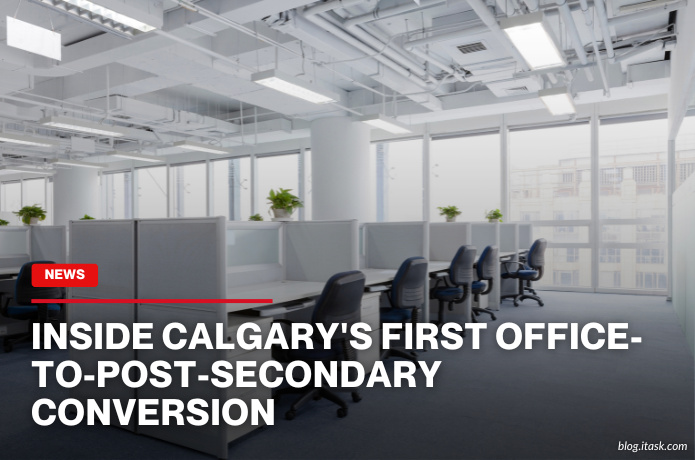Inside Calgary's First Office-To-Post-Secondary Conversion
Inside Calgary's First Office-To-Post-Secondary Conversion

The City of Calgary has launched a new development incentive program that pays building owners to turn empty office space into places that new businesses and institutions can use. It started in 2021 for residential projects with a grant of $75 per square foot. In March 2023, the city expanded the scheme to include office-to-post-secondary conversions, offering $50 per square foot for space converted into educational use.
The first project under this new post-secondary track is happening at 801 7th Avenue SW—commonly called the Nexen Building. It’s a 37-storey office tower built in 1982 and owned by Ursataur Capital Management. The plan is to convert nine floors, about 180,000 square feet, into classrooms, studios, workshops, and common areas for the University of Calgary’s School of Architecture, Planning and Landscape (SAPL).
A large part of the building stays as is. Because it’s a registered heritage structure, the original exterior façade will be preserved. Inside, the layout works well for a design school: there are no interior columns to get in the way, and the open, shallow floor plate lets in a lot of natural light. That makes it a good match for studio spaces and design classrooms.
The building’s public areas are also getting a refresh. Architects redesigned the main lobby and atrium to create a light-filled, open social stair that connects the first and second levels. A sculptural spiral staircase and digital art installation now serve both as decoration and wayfinding tools. The overall design brings together natural materials, curves, textures, and lighting inspired by the northern lights.
Construction is underway as of December 2024, and the University expects to move students into the space starting in January 2026. Around 1,200 students from the SAPL program will relocate downtown. That move is expected to bring more life and business to the surrounding areas near Century Gardens, helping reduce the amount of empty office space and boosting property values.
Calgary officials say this office-to-post-secondary project proves the conversion incentive model works for more than just homes. It shows how older, unused office buildings can become hubs for education, creativity, and community. Officials hope future conversions—funded by similar grants—will continue to support downtown renewal, add daytime and evening foot traffic, and make the core more vibrant.
